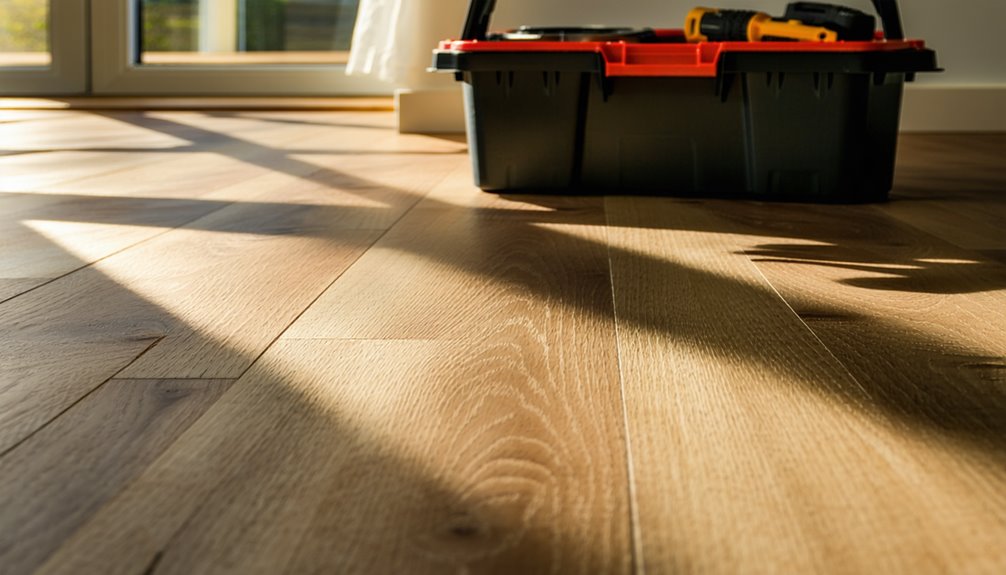When you're looking to install vinyl plank flooring, you can expect costs to range from $3 to $10 per square foot. This price includes both materials and labor. Vinyl planks themselves cost between $2 and $7 per square foot, depending on quality and brand. Labor adds another $1 to $3 per square foot. If you choose to DIY, you can save on labor costs but factor in the price of tools and any potential mistakes. Higher-quality planks offer better durability, ultimately saving you money on maintenance. If you keep going, you'll find more valuable insights to help with your project.
Overview of Vinyl Plank Flooring Costs
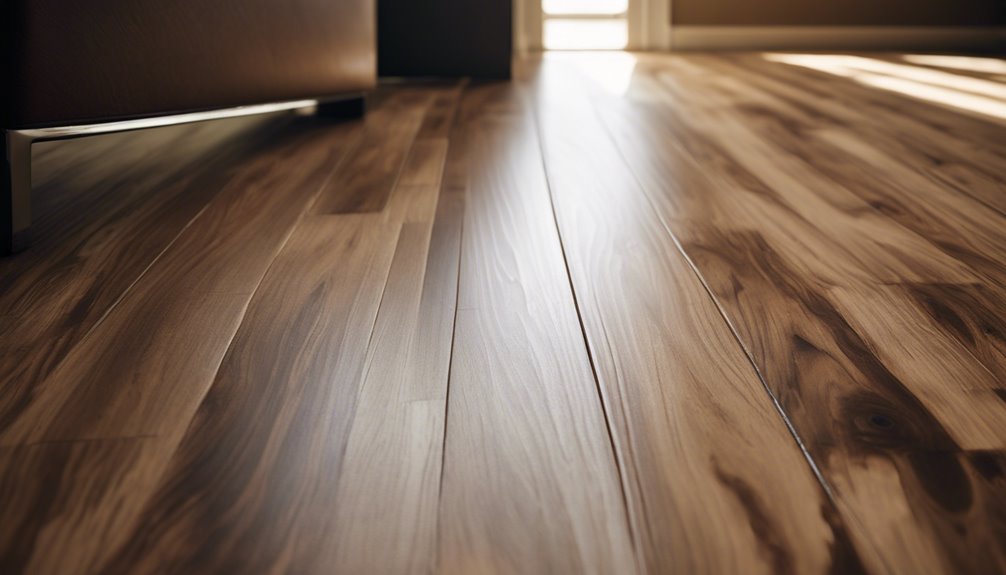
When considering a home renovation, understanding the costs associated with vinyl plank flooring can be vital. Vinyl plank styles vary widely, from luxurious looks that mimic hardwood to budget-friendly options that still offer durability. You'll want to assess the specific style you like, as this can impact your overall investment.
Installation techniques also play an important role in the final cost. DIY installation can save you money, but if you're not confident, hiring professionals guarantees a polished result. Factor in potential costs for tools or underlayment if you tackle it yourself. By grasping these elements, you'll be better prepared to make informed choices that align with your vision and budget, giving you the freedom to create a space you love.
Material Costs Breakdown
The cost of materials for vinyl plank flooring typically ranges from $2 to $7 per square foot, depending on the quality and design you choose. Higher material quality usually translates to better durability and aesthetic appeal, so it's worth considering your long-term needs. Here's a quick breakdown of factors influencing costs:
- Thickness of planks: Thicker planks often cost more but offer better sound insulation.
- Texture and finish: More intricate designs raise prices.
- Brand reputation: Well-known brands may charge a premium.
- Water resistance: Waterproof options can be pricier but are great for moisture-prone areas.
- Installation techniques: Some methods require more advanced materials, impacting overall costs.
Choosing wisely can enhance your space while staying within budget!
Labor Costs for Installation
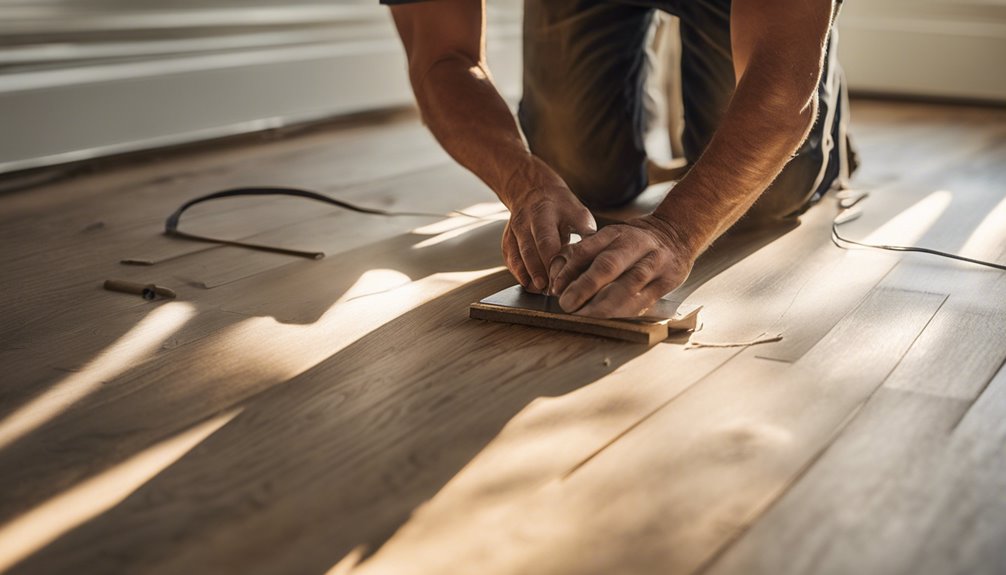
When it comes to installing vinyl plank flooring, understanding labor costs is essential for your budget. Average labor rates can vary based on your location and the complexity of the job, so it's important to take into account these factors. By knowing what to expect, you can make a more informed decision and guarantee a smooth installation process.
Average Labor Rates
Installing vinyl plank flooring typically comes with labor costs that can range from $1 to $3 per square foot, depending on various factors. Labor market trends and regional variations can greatly influence these rates, so it's wise to get multiple quotes before you start.
Here are some key points to take into account:
- Experience Level: More skilled installers usually charge higher rates.
- Job Size: Larger projects may offer better per-square-foot pricing.
- Location: Urban areas often have higher labor costs than rural ones.
- Seasonality: Busy seasons can drive up labor rates.
- Installer Type: Hiring an independent contractor vs. a company can impact costs.
Understanding these factors can help you make informed decisions for your flooring project.
Factors Affecting Costs
Several factors can greatly affect labor costs for installing vinyl plank flooring. The complexity of your project plays an essential role; if you choose intricate installation techniques, expect higher labor rates. Additionally, local market conditions and the experience level of the installer will influence costs. If your existing flooring needs removal or if there's extensive subfloor repair required, you might see an increase in labor expenses. Don't forget about the long-term aspect—proper flooring maintenance can reduce future costs. Investing in skilled professionals now can save you money down the line, ensuring your flooring stays in top shape. Remember, quality installation is key to enjoying your vinyl plank flooring for years to come.
Additional Expenses to Consider
When installing vinyl plank flooring, it's important to factor in additional expenses that can add up quickly. You'll need to evaluate costs for underlayment and padding, as well as any charges for removing old flooring. Don't forget about the tools and supplies you'll need to complete the installation, which can impact your overall budget.
Underlayment and Padding Costs
While you might focus primarily on the price of vinyl plank flooring itself, don't overlook the costs associated with underlayment and padding. These additional expenses can greatly influence your budget. Underlayment types vary, and you'll want to evaluate the right padding thickness for your space to enhance comfort and sound absorption.
Here are some key factors to keep in mind:
- Material: Choose between foam, cork, or rubber underlayment.
- Thickness: Thicker padding often means better soundproofing.
- Moisture barrier: Essential for areas prone to dampness.
- Installation costs: Factor in labor if you're hiring professionals.
- Warranty: Some underlayments may offer extended warranties.
Investing in quality underlayment and padding means enjoying your new flooring for years to come!
Removal of Old Flooring
After considering the costs of underlayment and padding, you might realize that removing old flooring is another expense that can impact your overall budget. Whether you're tackling the project yourself or hiring professionals, old flooring removal can add up. If you decide to DIY, be prepared for several preparation steps, like clearing out furniture and ensuring proper ventilation. You'll also need tools for lifting and scraping up the old material, which can be an added cost. If you hire help, consider quotes from different contractors to find a balance between quality and cost. Ultimately, budgeting for this step will help you achieve that fresh, new look without any unpleasant surprises.
Installation Tools and Supplies
Installing vinyl plank flooring requires several essential tools and supplies that can add to your overall costs. To guarantee a smooth installation, you'll need to gather the right installation tools and necessary supplies. Here's a quick list to help you get started:
- Measuring tape
- Utility knife
- Tapping block
- Spacers
- Flooring underlayment
These items are vital for achieving a professional-looking finish and making the process easier. While you might have some tools on hand, purchasing or renting the right equipment can help you avoid frustration down the line. Remember, investing in quality tools pays off in the long run, giving you the freedom to tackle your flooring project with confidence and efficiency.
DIY vs. Professional Installation
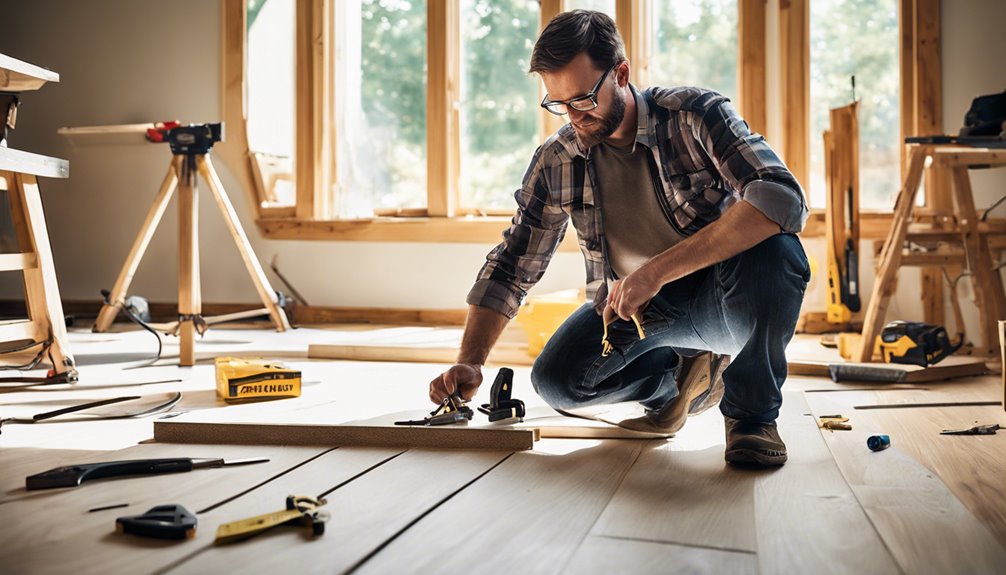
Are you considering whether to tackle the installation of vinyl plank flooring yourself or hire a professional? Weighing your options can feel liberating. DIY benefits include saving money and gaining hands-on experience, but it requires specific skill requirements and might extend your installation time. On the other hand, professional expertise guarantees a polished finish and adherence to warranty implications, which might save you headaches down the line. While you'll find a cost comparison leaning towards DIY, consider the potential hidden costs of mistakes. If you're confident in your abilities and have the time, going DIY can be rewarding. But if you want peace of mind and a guaranteed outcome, hiring a pro could be worth it. Choose what fits your vision best!
Factors Affecting Total Costs
Choosing between DIY and professional installation is just the first step; understanding the factors that influence total costs is equally important. Here are some key elements to contemplate:
- Material Quality: Different vinyl plank options can vary widely in price.
- Installation Techniques: Some methods are more labor-intensive, affecting labor costs.
- Flooring Maintenance: Reflect on how much upkeep your choice requires over time.
- Room Size and Layout: Larger or more complex spaces can increase costs.
- Geographic Location: Prices for labor and materials can differ based on your area.
Average Cost per Square Foot

When it comes to estimating the average cost per square foot for vinyl plank flooring, you'll find that prices can range considerably based on various factors. Typically, you can expect to pay between $2 and $7 per square foot, factoring in the quality and brand. Higher-end options often boast improved vinyl plank durability, which can save you money on flooring maintenance down the line. Cheaper options may be tempting, but they might not hold up as well in high-traffic areas. Ultimately, investing in quality flooring can enhance your space and provide you with the freedom to enjoy your home without frequent repairs. So, consider your priorities and choose wisely for long-lasting satisfaction.
Budgeting Tips for Flooring Projects
How can you effectively budget for your flooring project without breaking the bank? Start by understanding your budget allocation and identifying areas for flooring savings. Here are some practical tips to help you stay on track:
- Set a clear budget: Know exactly what you can afford before shopping.
- Research materials: Compare prices and quality of different vinyl plank options.
- DIY installation: Consider doing it yourself to save on labor costs.
- Plan for extras: Account for underlayment, trim, and other materials in your budget.
- Shop sales: Keep an eye out for discounts or seasonal sales to maximize your flooring savings.
Long-Term Value of Vinyl Plank Flooring
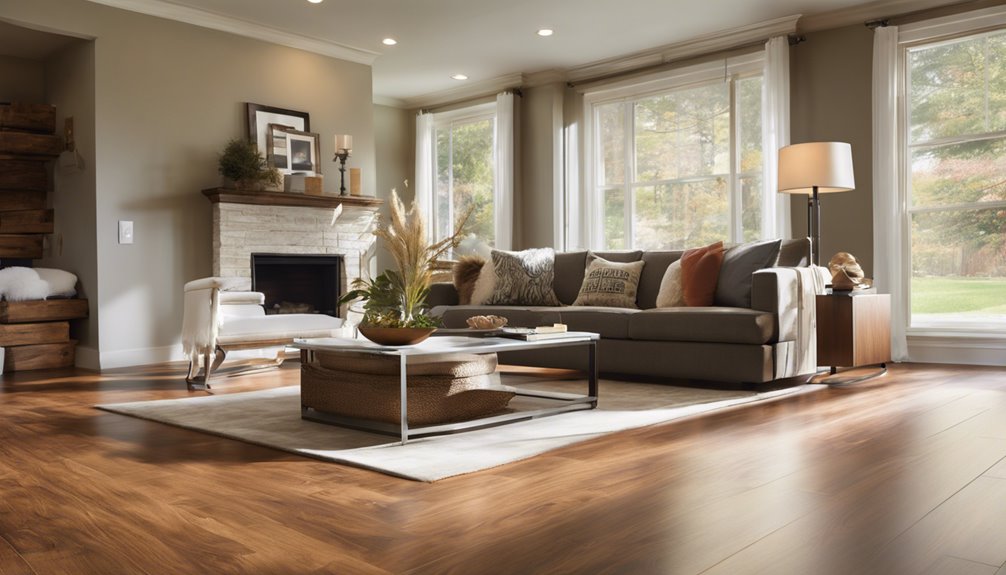
Investing in vinyl plank flooring offers remarkable durability and aesthetic appeal, making it a smart choice for homeowners seeking long-term value. With its resistance to scratches, stains, and moisture, you can enjoy peace of mind knowing your floors will last. This durability translates into long-term savings, as you won't need to replace or repair them frequently. Plus, maintenance considerations are minimal; regular sweeping and occasional mopping are typically all it takes to keep your floors looking pristine. By choosing vinyl plank flooring, you not only enhance your home's beauty but also make a wise financial decision that supports your desire for freedom and flexibility in your living space. Enjoy the benefits today and in the years to come!
Frequently Asked Questions
What Is the Lifespan of Vinyl Plank Flooring?
When considering vinyl plank flooring, you'll find that its lifespan typically ranges from 10 to 25 years, depending on the quality and maintenance. Vinyl durability plays a vital role in flooring longevity, so investing in higher-quality options can pay off in the long run. Regular cleaning and avoiding excessive moisture can help extend its life, giving you the freedom to enjoy your stylish floors for years without the worry of frequent replacements.
Can Vinyl Plank Flooring Be Installed Over Existing Floors?
Absolutely, you can install vinyl plank flooring over existing floors, which saves you time and effort! Just make sure the surface is clean, dry, and level. If your current flooring is too uneven or damaged, consider fixing it first. This method not only simplifies the process but also lets you enjoy a fresh look without the hassle of tearing up the old floors. So, go ahead and transform your space effortlessly!
Is Vinyl Plank Flooring Waterproof?
Yes, vinyl plank flooring is waterproof, making it an excellent choice for areas prone to moisture, like kitchens and bathrooms. Its vinyl durability means it can withstand spills and pet accidents without damage. You'll appreciate the waterproof benefits, allowing you to enjoy freedom from worries about water ruining your floors. Plus, the easy maintenance guarantees you can focus on living your life rather than constantly cleaning up messes.
How Do I Clean and Maintain Vinyl Plank Flooring?
To keep your vinyl plank flooring looking great, establish a regular maintenance routine. Start with basic cleaning tips: sweep or vacuum regularly to remove dirt, and use a damp mop with a mild cleaner for deeper cleans. Avoid harsh chemicals or abrasive tools that could damage the surface. Consider placing mats at entryways to minimize dirt. With consistent care, you'll enjoy your flooring's beauty and durability for years to come.
Are There Eco-Friendly Vinyl Plank Flooring Options Available?
Imagine walking on clouds while treading lightly on the Earth. Yes, there are eco-friendly vinyl plank flooring options available that use sustainable materials, reducing their environmental impact. Brands now offer products made from recycled content and biodegradable components, ensuring you can enjoy beautiful floors without compromising your values. By choosing these options, you're not only enhancing your space but also contributing to a greener future—one step at a time.

